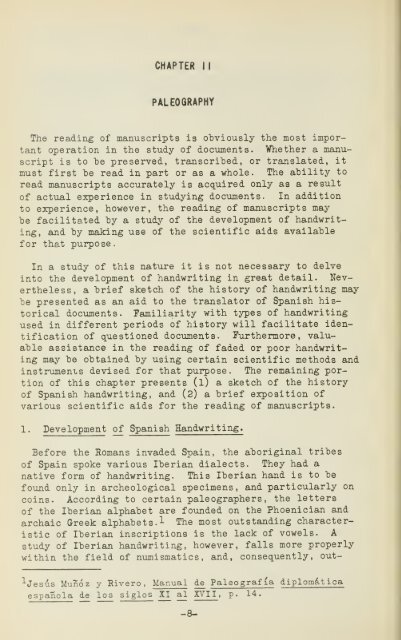Handbook for translators of Spanish historical ... - University Library
Handbook for translators of Spanish historical ... - University Library
Handbook for translators of Spanish historical ... - University Library
You also want an ePaper? Increase the reach of your titles
YUMPU automatically turns print PDFs into web optimized ePapers that Google loves.
CHAPTER II<br />
PALEOGRAPHY<br />
The reading <strong>of</strong> manuscripts is obviously the most important<br />
operation in the study <strong>of</strong> documents. Whether a manuscript<br />
is to "be preserved, transcribed, or translated, it<br />
must first "be read in part or as a whole. The ahility to<br />
read manuscripts accurately is acquired only as a result<br />
<strong>of</strong> actual experience in studying documents. In addition<br />
to experience, however, the reading <strong>of</strong> manuscripts may<br />
he facilitated hy a study <strong>of</strong> the development <strong>of</strong> handwriting,<br />
and by making use <strong>of</strong> the scientific aids available<br />
<strong>for</strong> that purpose.<br />
In a study <strong>of</strong> this nature it is not necessary to delve<br />
into the development <strong>of</strong> handwriting in great detail. Nevertheless,<br />
a brief sketch <strong>of</strong> the history <strong>of</strong> handwriting may<br />
be presented as an aid to the translator <strong>of</strong> <strong>Spanish</strong> <strong>historical</strong><br />
documents. Familiarity with types <strong>of</strong> handwriting<br />
used in different periods <strong>of</strong> history will facilitate identification<br />
<strong>of</strong> questioned documents. Furthermore, valuable<br />
assistance in the reading <strong>of</strong> faded or poor handwriting<br />
may be obtained by using certain scientific methods and<br />
instruments devised <strong>for</strong> that purpose. The remaining portion<br />
<strong>of</strong> this chapter presents (l) a sketch <strong>of</strong> the history<br />
<strong>of</strong> <strong>Spanish</strong> handwriting, and (2) a brief exposition <strong>of</strong><br />
various scientific aids <strong>for</strong> the reading <strong>of</strong> manuscripts.<br />
1. Development <strong>of</strong> <strong>Spanish</strong> Handwriting.<br />
Be<strong>for</strong>e the Romans invaded Spain, the aboriginal tribes<br />
<strong>of</strong> Spain spoke various Iberian dialects. They had a<br />
native <strong>for</strong>m <strong>of</strong> handwriting. This Iberian hand is to be<br />
found only in archeological specimens, and particularly on<br />
coins. According to certain paleographers, the letters<br />
<strong>of</strong> the Iberian alphabet are founded on the Phoenician and<br />
archaic Greek alphabets. ^ The most outstanding characteristic<br />
<strong>of</strong> Iberian inscriptions is the lack <strong>of</strong> vowels. A<br />
study <strong>of</strong> Iberian handwriting, however, falls more properly<br />
within the field <strong>of</strong> numismatics, and, consequently, out-<br />
de Paleograf la diplomat ica<br />
Manual •^Jesus Munoz y Rivero ,<br />
espanola de los siglos XI al XVII , p. 14.<br />
-8-










![Novellen [microform] - University Library](https://img.yumpu.com/21939450/1/171x260/novellen-microform-university-library.jpg?quality=85)
![Anecdota Chisiana de re metrica [microform]](https://img.yumpu.com/21939448/1/190x239/anecdota-chisiana-de-re-metrica-microform.jpg?quality=85)



![Schollenbruch [microform] : Gedichte - University Library](https://img.yumpu.com/21939437/1/174x260/schollenbruch-microform-gedichte-university-library.jpg?quality=85)

